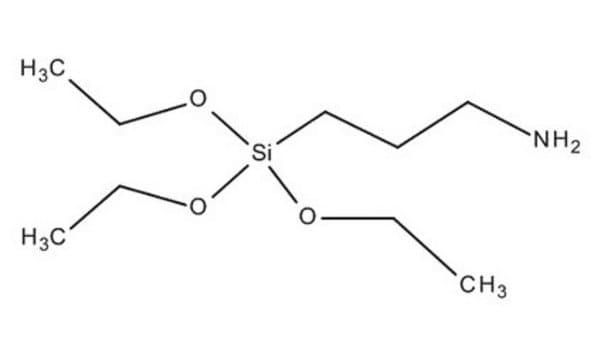706493
(3-Aminopropyl)triethoxysilane
packaged for use in deposition systems, ≥98%
Synonim(y):
3-Triethoxysilylpropylamine, APTES, APTS
About This Item
Polecane produkty
Poziom jakości
Próba
≥98%
Postać
liquid
tw
217 °C/760 mmHg (lit.)
gęstość
0.946 g/mL at 25 °C (lit.)
ciąg SMILES
CCO[Si](CCCN)(OCC)OCC
InChI
1S/C9H23NO3Si/c1-4-11-14(12-5-2,13-6-3)9-7-8-10/h4-10H2,1-3H3
Klucz InChI
WYTZZXDRDKSJID-UHFFFAOYSA-N
Szukasz podobnych produktów? Odwiedź Przewodnik dotyczący porównywania produktów
Opis ogólny
Zastosowanie
Hasło ostrzegawcze
Danger
Zwroty wskazujące rodzaj zagrożenia
Zwroty wskazujące środki ostrożności
Klasyfikacja zagrożeń
Acute Tox. 4 Oral - Eye Dam. 1 - Skin Corr. 1B - Skin Sens. 1
Kod klasy składowania
8A - Combustible corrosive hazardous materials
Klasa zagrożenia wodnego (WGK)
WGK 1
Temperatura zapłonu (°F)
199.4 °F - closed cup
Temperatura zapłonu (°C)
93 °C - closed cup
Środki ochrony indywidualnej
Faceshields, Gloves, Goggles, type ABEK (EN14387) respirator filter
Certyfikaty analizy (CoA)
Poszukaj Certyfikaty analizy (CoA), wpisując numer partii/serii produktów. Numery serii i partii można znaleźć na etykiecie produktu po słowach „seria” lub „partia”.
Masz już ten produkt?
Dokumenty związane z niedawno zakupionymi produktami zostały zamieszczone w Bibliotece dokumentów.
Klienci oglądali również te produkty
Produkty
Atomic Layer Deposition (ALD) technology ensures uniform coating on complex 3D surfaces with precise chemisorption cycles.
Nanocomposite Coatings with Tunable Properties Prepared by Atomic Layer Deposition
Silica's versatility spans various industries, including biomedical applications.
Thin film photovoltaic devices have become increasingly important in efficiently harnessing solar energy to meet consumer demand.
Nasz zespół naukowców ma doświadczenie we wszystkich obszarach badań, w tym w naukach przyrodniczych, materiałoznawstwie, syntezie chemicznej, chromatografii, analityce i wielu innych dziedzinach.
Skontaktuj się z zespołem ds. pomocy technicznej











![[3-(Diethylamino)propyl]trimethoxysilane 96%](/deepweb/assets/sigmaaldrich/product/structures/369/056/3e3cd51a-0662-4e06-a10a-866ae1d6c290/640/3e3cd51a-0662-4e06-a10a-866ae1d6c290.png)
![N-[3-(Trimethoxysilyl)propyl]ethylenediamine 97%](/deepweb/assets/sigmaaldrich/product/structures/149/508/f87a9a89-f138-4c5e-9fe0-6561914241c3/640/f87a9a89-f138-4c5e-9fe0-6561914241c3.png)


